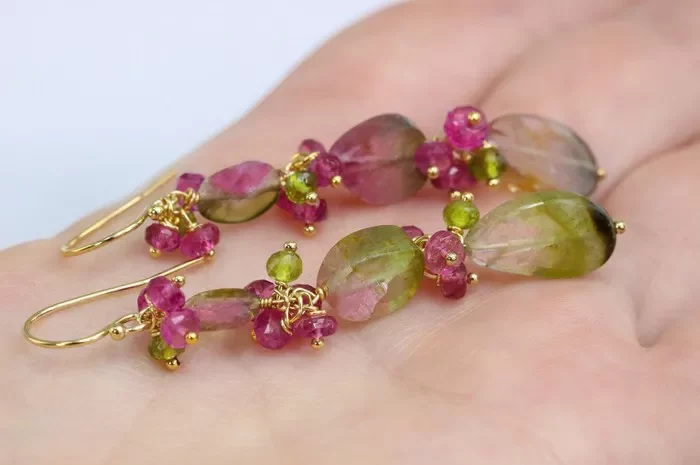Tourmaline is a captivating gemstone prized for its wide range of colors, unique crystal formations, and affordability compared to other precious gemstones. However, the cost of tourmaline can vary significantly depending on several factors, including color, clarity, carat weight, and origin. In this article, we’ll explore the pricing of tourmaline and what influences its value in the gemstone market.
Introduction to Tourmaline
Tourmaline is a complex boron silicate mineral that comes in a variety of colors, including green, pink, blue, red, yellow, and colorless. It is renowned for its pleochroism, a phenomenon where the gemstone exhibits different colors when viewed from different angles. This unique property adds to tourmaline’s allure and makes it a favorite among gemstone enthusiasts and collectors.
The name “tourmaline” is derived from the Sinhalese word “turamali,” which means “mixed colors,” reflecting the gemstone’s diverse color palette. Tourmaline has been used as a gemstone for centuries, with historical references dating back to ancient civilizations such as the Egyptians and the Chinese. Today, tourmaline remains a popular choice for jewelry due to its beauty, durability, and versatility.
Factors Affecting the Cost of Tourmaline
Several factors influence the cost of tourmaline, including color, clarity, carat weight, cut, and origin. Let’s explore each of these factors in more detail:
Color: The color of tourmaline is one of the most critical factors in determining its value. Certain colors, such as vivid green (known as “chrome tourmaline”) or intense pink (known as “rubellite”), command higher prices in the market due to their rarity and desirability. Other sought-after colors include blue (indicolite), red (paraiba), and bi-color or tri-color varieties. The saturation, intensity, and consistency of color also play a significant role in determining the value of tourmaline.
Clarity: Clarity refers to the presence of internal characteristics, known as inclusions, within the tourmaline. While some inclusions are acceptable and may even enhance the gemstone’s beauty, stones with excellent clarity and transparency are more valuable. Eye-clean tourmalines with minimal visible inclusions command higher prices than heavily included specimens.
Carat Weight: As with other gemstones, the size of a tourmaline can significantly affect its price. Larger tourmalines are rarer and thus more valuable than smaller stones. However, the price per carat tends to increase exponentially as the carat weight of the tourmaline increases, meaning that larger stones can be significantly more expensive on a per-carat basis.
Cut: The cut of a tourmaline can greatly impact its beauty, brilliance, and overall value. Well-cut tourmalines exhibit optimal proportions, symmetry, and polish, enhancing their sparkle and light performance. Popular cuts for tourmalines include round, oval, cushion, and emerald cuts, although other fancy shapes may also be available. A high-quality cut can maximize the stone’s color, minimize any potential color zoning or extinction, and create an attractive play of light within the gemstone.
Origin: The geographic origin of a tourmaline can also influence its value and desirability. Certain sources are known for producing tourmalines with specific colors or characteristics that are highly prized in the market. For example, Paraiba tourmalines from Brazil and Mozambique are renowned for their vivid blue to green colors and exceptional clarity. Other notable sources of tourmaline include Afghanistan, Madagascar, Nigeria, and the United States.
How Expensive is Tourmaline?
The cost of tourmaline can vary widely depending on the factors mentioned above. In general, tourmaline is considered more affordable than other precious gemstones such as diamonds, rubies, and sapphires, making it an attractive option for those seeking beauty and variety without breaking the bank.
At the lower end of the price spectrum, common varieties of tourmaline such as black tourmaline and brown tourmaline (also known as “dravite”) may be relatively inexpensive and readily available. These varieties are often used in jewelry for their earthy tones and affordability.
On the other hand, rare and exceptional varieties of tourmaline, such as Paraiba tourmaline, can command prices that rival or even exceed those of top-quality diamonds and rubies. Paraiba tourmalines are prized for their vivid blue to green colors, exceptional clarity, and intense fluorescence under UV light. These rare gemstones are highly sought after by collectors and connoisseurs and can fetch prices of tens of thousands of dollars per carat.
Other valuable varieties of tourmaline include rubellite (intense pink to red), chrome tourmaline (vivid green), and indicolite (blue). While these gemstones may not reach the same astronomical prices as Paraiba tourmalines, they are still highly desirable and can command premium prices in the market, especially for stones with exceptional color, clarity, and size.
Conclusion
In conclusion, the cost of tourmaline can vary widely depending on factors such as color, clarity, carat weight, cut, and origin. While some varieties of tourmaline may be relatively affordable and accessible, others, such as Paraiba tourmaline, are exceptionally rare and valuable, commanding prices that rival those of top-quality diamonds and rubies. Whether you’re seeking an affordable gemstone for everyday wear or a rare and exceptional specimen for your collection, tourmaline offers a wide range of options to suit every taste and budget.


